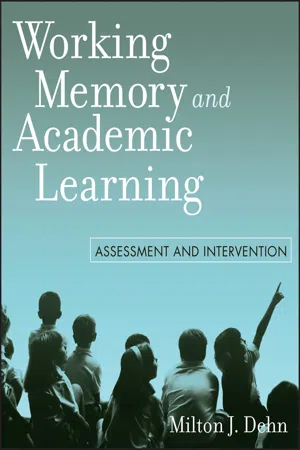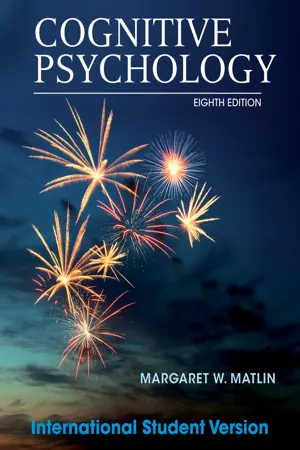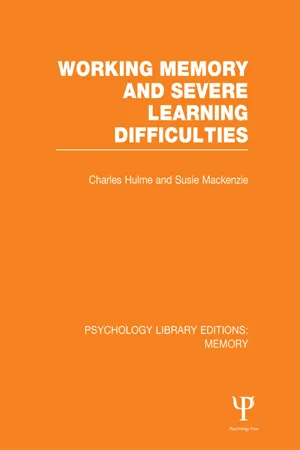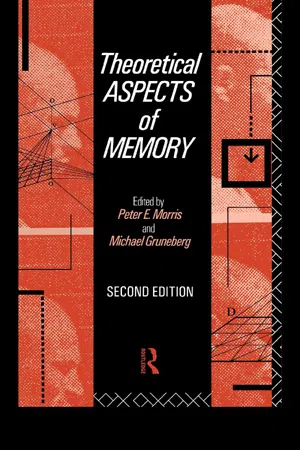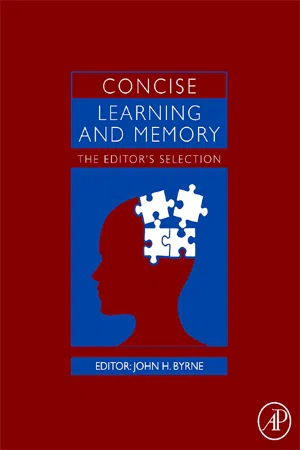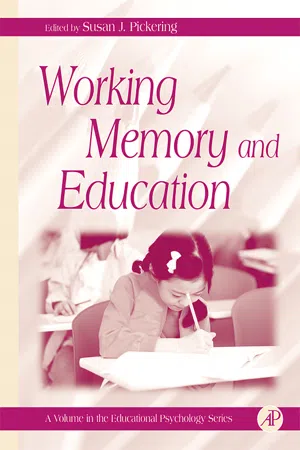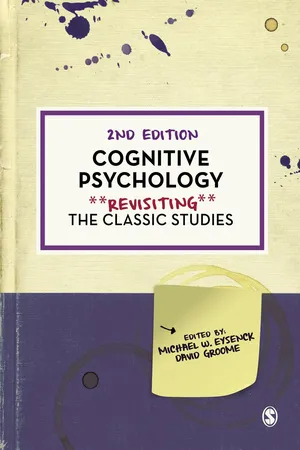Psychology
Baddeley
Baddeley is a prominent cognitive psychologist known for his influential model of working memory, which consists of the central executive, phonological loop, and visuospatial sketchpad. His model revolutionized the understanding of short-term memory and its role in cognitive processes. Baddeley's work has had a significant impact on the field of psychology, particularly in the study of memory and cognitive functioning.
Written by Perlego with AI-assistance
Related key terms
1 of 5
10 Key excerpts on "Baddeley"
- eBook - ePub
Working Memory and Academic Learning
Assessment and Intervention
- Milton J. Dehn(Author)
- 2011(Publication Date)
- Wiley(Publisher)
The two British psychologists developed the idea of a working memory within short-term memory. They defined working memory as “a system for the temporary holding and manipulation of information during the performance of a range of cognitive tasks such as comprehension, learning, and reasoning” (Baddeley, 1986, p. 34). As originally proposed, Baddeley and Hitch’s multifaceted model comprised three aspects of working memory—a phonological loop, a visuospatial sketchpad, and a central executive that controlled the other two subsystems, referred to as slave systems. In effect, Baddeley’s model is hierarchical, with the central executive as the top-level, domain-free factor that controls all the subcomponents. Apparently, Baddeley views the central executive as the essence of working memory; he usually refers to the two subsidiary systems as short-term memory components. Recently, Baddeley (2000) added another subcomponent—the episodic buffer (see Fig. 2.3). Over the past 3 decades a large number of studies have investigated Baddeley’s model. Overwhelmingly, the empirical evidence supports the division of working memory into modality-based short-term stores and a modality-free processing center where the work of working memory is conducted. FIGURE 2.3 Baddeley’s (2006) working memory model. The Phonological Loop The phonological loop, originally referred to as the articulatory loop, is a limited-capacity, speech-based store of verbal information (Baddeley, 1986, 2003a; Baddeley, Gathercole, & Papagno, 1998). Baddeley divides the loop into two subcomponents: a temporary, passive phonological input store and a subvocal, articulatory rehearsal process. Orally presented verbal information gains immediate, direct, and automatic access to the phonological loop, where it is briefly stored in phonological form (Hitch, 1990; Logie, 1996). The phonological loop is analogous to an audio tape recorder loop of specific length - eBook - PDF
- Margaret W. Matlin(Author)
- 2014(Publication Date)
- Wiley(Publisher)
(Think about it: Did you in fact keep those initial words in your memory until you reached the word end?) As you’ll see in this section of Chapter 4, people also use this kind of working memory for a wide range of cognitive tasks, such as language comprehension, mental arithmetic, reasoning, and problem solving (Baddeley & Hitch, 1974; Logie, 2011). According to the working-memory approach proposed by Baddeley, our imme- diate memory is a multipart system that temporarily holds and manipulates information while we perform cognitive tasks. Baddeley’s model of working memory is different from earlier models because he proposed multiple components for our working memory (Schwartz, 2011). Figure 4.4 illustrates the current design of the model, FIGURE 4.4 The Working-Memory Approach: A Simplified Version of Alan Baddeley’s (2000b) Model of Working Memory. Central Executive Long-Term Memory Episodic Buffer Phonological Loop Visuospatial Sketchpad Note: This diagram shows the phonological loop, the visuospatial sketchpad, the central executive, and the episodic buffer—as well as their interactions with long-term memory. Source: Baddeley, A. D. (2000b). The episodic buffer: A new component of working memory? Trends in Cognitive Sciences, 4, 417–423. The Working-Memory Approach 109 featuring the phonological loop, the visuospatial sketchpad, the central executive, and the episodic buffer, which was added more recently (Baddeley, 2000a, 2000b, 2001; Baddeley et al., 2009). Baddeley’s approach emphasizes that working memory is not simply a passive storehouse with a number of shelves to hold partially processed information until it moves on to another location (presumably long-term memory). Instead, Baddeley emphasizes that we manipulate information. As a result, your working memory is more like a workbench where material is constantly being handled, combined, and transformed. Clearly, Baddeley’s model is consistent with Theme 1 of this textbook. - eBook - ePub
- JOHN P CUTTING, Anthony David(Authors)
- 2019(Publication Date)
- Psychology Press(Publisher)
The chapter is organised into several sections. First, a review of the original cognitive model of working memory is presented (Baddeley, 1986). The implications for understanding schizophrenia drawn from this model are explored, as are the limitations of such a cognitive framework. Next, working memory as conceptualised by contemporary researchers investigating the functions of prefrontal cortex from primate and cognitive neuroscience studies will be examined. Taken together, we believe that these studies appear to specify a cognitive construct from which various core cognitive abnormalities of schizophrenia might be understood. Furthermore, we attempt to provide evidence that the functions of working memory rely on the integrity of catecholamine systems, all of which may be impaired in patients with schizophrenia. Finally, the last section summarises the utility of the working memory construct.COGNITIVE MODEL OF WORKING MEMORYBaddeley (1986, 1992) proposed that working memory is a general-purpose system involved in a wide range of cognitive operations requiring the simultaneous storage and processing of information. This concept of working memory involves two modality-specific short-term stores and a “central executive”, which is responsible for the overall co-ordination of information processing. The storage of transient information is conducted by two peripheral “slave” systems—the articulatory loop, and the visuospatial scratch-pad—specialised for the short term retention of phonological and visual information respectively. Each of these systems will be discussed briefly; the reader is referred to Baddeley (1986, 1990) for a more detailed review.The articulatory loop subsystem (also commonly referred to as the phonological loop), is specialised for the processing of auditory material, is of limited capacity, and is itself composed of two subsystems, a phonological store and an articulatory rehearsal mechanism (Baddeley et al., 1984; Vallar & Baddeley, 1984). The articulatory loop subsystem may account for a realm of phenomena associated with memory span (Baddeley, 1990). The subsystem thought to be responsible for the processing and short-term storage of visuospatial material including abstract patterns and matrices is called the visual sketch/scratch-pad system (Baddeley & Lieberman, 1980). In contrast to the articulatory loop, the characteristics of the visual spatial scratch-pad have been less well defined and investigated. - Charles Hulme, Susie Mackenzie(Authors)
- 2014(Publication Date)
- Psychology Press(Publisher)
Resdearch generated by the modal model paid lip-service to the idea that short-term memory played a role as a working memory system in more complex tasks, such as reading and mental arithmetic. However, research within this framework concentrated very much on understanding the mechanisms underlying traditional short-term memory tasks, such as memory span, at the expense of trying, directly, to relate short-term memory to the performance of these more complex skills.Baddeley and Hitch (1974) explicitly set out to redress this imbalance and, in the process, their classic work highlighted certain shortcomings of the modal model. This led them to propose a model of working memory which puts great emphasis on the functions of memory in the processing and flow of information in everyday activities, such as the need to retain and integrate information for short periods when reading. The main difference between the working memory model and previous concepts of short-term memory is that it is seen as a complex of stores and systems rather than as a unitary store (Baddeley, 1983, 1986; Baddeley & Hitch, 1974). Baddeley (1983, 1986) describes working memory as a limited capacity central executive interacting with a set of passive slave sub-systems. The basic structure of the model is outlined in Fig.2.1 .Baddeley describes two particular slave sub-systems both used for temporary storage of different classes of information: the speech-based articulatory loop; and the visual image scratch-pad. As memory span is an auditory test, with verbal recall, it is the speech-based articulatory loop that is particularly relevant to memory span performance. The visual image scratch-pad is concerned, as its name suggests, with the maintenance of visuo-spatial information in short-term memory. As such it has little relevance to explanations of auditory verbal short-term memory, and will not be dealt with further here.The central executive, described by Baddeley (1983, 1986), is of limited capacity and controls the manipulation and flow of information, while a small amount of information may be retained in slave stores, such as the articulatory loop. The importance of the articulatory loop is that once verbal information is placed in the loop it can be kept available (using rehearsal) without taking up the processing capacity of the executive. The remaining capacity of the executive is therefore available for retrieving relevant information from other parts of the memory system, deciding what is or is not relevant, and forming associations and relationships between items.- eBook - ePub
Theoretical Aspects of Memory
Volume 2
- Michael Gruneberg, Peter E Morris, Michael Gruneberg, Peter E Morris(Authors)
- 2006(Publication Date)
- Routledge(Publisher)
(Baddeley et al. 1988). P.V. was unable to retain unfamiliar phonological material even temporarily, and so proved completely unable to learn new words. Once again, a short-term memory deficit resulted in a corresponding impairment of long-term learning for that domain of information. The case of E.L.D. is an important one. It provides a clear demonstration that, despite theoretical debates and uncertainties about how best to characterize the mechanisms and processes embodied in the sketchpad, it is a component of working memory which fulfils many useful functions in everyday life. Learning about new visual events is an ability which makes the human race particularly responsive to changes in the environment. The present evidence suggests that, without the sketchpad, our adaptability would be significantly reduced. THE CENTRAL EXECUTIVE Since Baddeley and Hitch (1974) first introduced the concept of the central executive, many different functions have been ascribed to the most complex and powerful component of the working memory model. It has been suggested that the central executive is involved in regulatory and control activities. Amongst these activities feature the control of attention and action, the regulation of the flow of information through components of the working memory system, and the retrieval of information from long-term memory. More generally, the central executive has been suggested to house consciousness. The central executive is also believed to possess both storage and processing capabilities that are fuelled by limited capacity processing resources. These resources are general purpose in nature, and so can be flexibly deployed in order to respond to a wide range of different informationprocessing requirements - eBook - PDF
Concise Learning and Memory
The Editor's Selection
- (Author)
- 2010(Publication Date)
- Academic Press(Publisher)
8.2 The Working Memory Model One influential theoretical account of working mem-ory has framed much of the research and thinking in this field for several decades. In 1974, Baddeley and Hitch advanced a model of working memory that has been substantially refined and extended over the intervening period. The influence of the working memory model extends far beyond the detailed structure of its cognitive processes, which are con-sidered in the following sections. The radical claim made by Baddeley and Hitch was that working mem-ory is a flexible multicomponent system that satisfies a wide range of everyday cognitive needs for tem-porary mental storage – in other words, it does important work for the user. The distinction between short-term memory and working memory is a key element in the philosophy of this approach. The term working memory refers to the whole set of cognitive processes that comprise the model, which as we will see includes higher-level attentional and executive processes as well as storage systems specialized for particular information domains. Activities that tap a broad range of the functions of working memory, including both storage and higher-level control func-tions, are often described as working memory tasks. The term short-term memory, on the other hand, is largely reserved for memory tasks that principally require the temporary storage of information only. In this respect, short-term memory tasks tap only a subset of working memory processes. Detailed exam-ples of each of these classes of memory task are provided in later sections. A further key element of the Baddeley and Hitch (1974) approach is its use of dual-task methodology to investigate the modular structure of the working memory system. These researchers have developed a set of laboratory techniques for occupying particular components of the working memory system, which can then be used to investigate the extent to which particular activities engage one or another compo-nent. - eBook - PDF
- Gary D. Phye(Author)
- 2006(Publication Date)
- Academic Press(Publisher)
CHAPTER 1 Working Memory: An Overview ALAN Baddeley University of York One might imagine that cognitive psychology and the study of education would be close companions, with the study of learning and memory pro-viding a theoretical basis for the study of education. I’m sad to say that is not the case. There have, of course, been psychologists concerned with cog-nition who have been extremely influential in the educational field; Piaget and Bruner are notable examples. However, neither of these has had a major impact on, or drawn from, mainstream cognitive psychology, at least over the last two or three decades. The problem has not been one of mutual antagonism, at least not by cognitive psychologists, who I am sure would be delighted to see their work influencing education; rather, the problem has been failure to address common problems using mutually understand-able concepts. Certainly, there are some notable exceptions, with topics such as reading, with institutions like the Learning Research and Developmental Center at the University of Pittsburgh, and with individuals such as John Bransford (1979) providing good examples. In general, however, those studying the cognitive psychology of learning and memory have tended to stay relatively close to the laboratory, and as far as I can ascertain, those studying education stay relatively close to the classroom. This certainly proved true in my case; as a newly appointed director of a Medical Research Council (MRC) unit, I initially proposed to concentrate on the basic skills of reading, writing, and arithmetic because of their rele-vance to education. This was firmly discouraged by the relevant MRC com-mittee who declared it beyond their remit. I therefore chose neuropsychology Working Memory and Education Copyright © 2006 by Academic Press. All rights of reproduction in any form reserved. 1 as a more appropriately medical area of applied research for my newly acquired unit. - eBook - PDF
What is Psychology?
Foundations, Applications, and Integration
- Ellen Pastorino, Susann Doyle-Portillo, Ellen Pastorino(Authors)
- 2021(Publication Date)
- Cengage Learning EMEA(Publisher)
For instance, as you read this page, you must access information that you have stored in long-term memory about the English language in order to pronounce and understand the words. As the words on the page enter your short-term memory, you already know what they mean and how they sound. The working memory view of memory can explain this, but the three-stages model cannot. In the working memory model, you can go to your long-term memories to help you process perceptual information in a top-down fashion, meaning that your perception is guided by your knowledge of the world (Logie, 1999; see Chapter 3). The Central Executive and Deficits in Memory Functioning One of the more prominent theories of a multicomponent working memory proposes that working memory contains a central executive component and several subordinate systems: the phonological loop, which processes and stores verbal and auditory infor- mation (such as the buzzing of a bee), the visuospatial sketchpad, which processes visual and spatial information (the sight of a bumblebee), and an episodic buffer that connects information in working memory to information found in long-term memory (such as knowing that bees can sting) (Baddeley, 1992, 2012; Baddeley, Allen, & Hitch, 2010; Baddeley & Hitch, 1974; Baddeley, Hitch, & Allen, 2019). The episodic buffer may also integrate information coming from different sources in working memory (Baddeley, 2012; Bahrami Balani, 2020). These systems are called subordinate sys- tems, because they fall under the control of the central executive ( ● FIGURE 7.7). The central executive functions as an attention-controlling mechanism within working memory. - eBook - PDF
What is Poetry?
Language and Memory in the Poems of the World
- Nigel Fabb(Author)
- 2015(Publication Date)
- Cambridge University Press(Publisher)
I will propose that the whole line of poetry fits into working memory (Fabb 2013a, 2014). Working memory: the Baddeley–Hitch model The approach to working memory taken in this book is that developed by Alan Baddeley in collaboration with Graham Hitch, Susan Gathercole and others Working memory: the Baddeley–Hitch model 173 (Baddeley and Hitch 1974; Gathercole 2007; Baddeley 2012). This is the most influential of the various theories of working memory, or of some similar limited capacity memory (a review of how working memory is instantiated in the brain is provided by D’Esposito and Postle 2015). Working memory is a structured psychological system, which at any time holds a small amount of material, including language, in order to process that material in specific ways. The material comes from sensory input, entering our minds when we hear the sounds of the words, or see them on the page. Material in working memory also comes from long-term memory, including the mental lexicon, our knowledge of language and our memory of the preceding dis- course. When we process language, we recognize the words by matching them to words in our mental lexicon, applying contextual knowledge to process the input, and drawing on linguistic knowledge. Though language held in working memory can be used to support cognitive activities, working memory is not where language is processed for meaning. Memory for a sentence and compre- hension of the sentence may be psychologically distinct processes (Gathercole 2007: 758). This is important, because though I claim that the line is held as a whole unit in working memory and that the added forms are processed there, I am not claiming that the line must be processed for meaning in working memory or that it must have a specific semantic coherence. Working memory is able to hold about fifteen syntactically connected English words. These are lexical words, including content words and grammatical words. - eBook - ePub
Cognitive Psychology
Revisiting the Classic Studies
- Michael W. Eysenck, David Groome, Michael W. Eysenck, David Groome(Authors)
- 2023(Publication Date)
- SAGE Publications Ltd(Publisher)
Figure 8.1 B, by suggesting that the contents of working memory are activated from long-term memory, not directly from sensory input. However, like Atkinson and Shiffrin, Cowan’s approach does not incorporate any clear distinction between control processes and temporary memory, and does not readily explain the specific verbal or visual short-term memory impairments in patients (see Logie, 2019). Cowan does not view working memory as clearly separate from the activated contents of long-term memory, although more recently he has argued for a distinction between ‘central and peripheral’ components of working memory (Alt et al., 2022; Cowan, Saults, & Blume, 2014; Ünal, Forsberg, Geary, & Cowan, 2022).The theoretical proposal in Baddeley and Hitch (1974) continues to be influential for groups in the UK and in other countries of Europe and to a certain extent in Asia and in Australia, as well as for some groups in North America. In 2022, Alan Baddeley had more than twice as many citations worldwide than he did in 2013, so the influence is growing, not waning, and the 1974 paper alone has been cited over 19,000 times since its first publication. However, it is not clear that authors who reference the 1974 classic paper have looked at the detail of the original paper, and many appear to include this reference in their papers because other researchers do so. For example, the 1974 paper is very commonly referenced as the source for the top part Figure 8.1 B, but that figure did not appear anywhere until it was included in a paper published by Baddeley in 1983.Also, rarely do contemporary papers on working memory refer to experimental findings in the 1974 paper that are still highly relevant to contemporary debates, such as whether or not control processes and short-term memory share a common resource. One contemporary approach, known as Time Based Resource Sharing (e.g., Barrouillet, Bernardin, & Camos, 2004; recent review in Barrouillet & Camos, 2021) has been based on precisely this assumption, that a common attentional resource can switch between focusing on retaining (refreshing) memory items and carrying out some ongoing, demanding cognitive task. The more time that is spent on the demanding cognitive task, the less refreshing there will be of the items in memory, and some of those items will be forgotten as a result. This general framework has been supported by a large number of empirical findings published over the last two decades. The argument is consistent with the interpretation of the Baddeley and Hitch (1974) experiments described earlier in which a memory load was combined with logical reasoning or language comprehension. Forgetting is thought to be due to decay of the memory trace over time or due to interference from the cognitive task.
Index pages curate the most relevant extracts from our library of academic textbooks. They’ve been created using an in-house natural language model (NLM), each adding context and meaning to key research topics.
